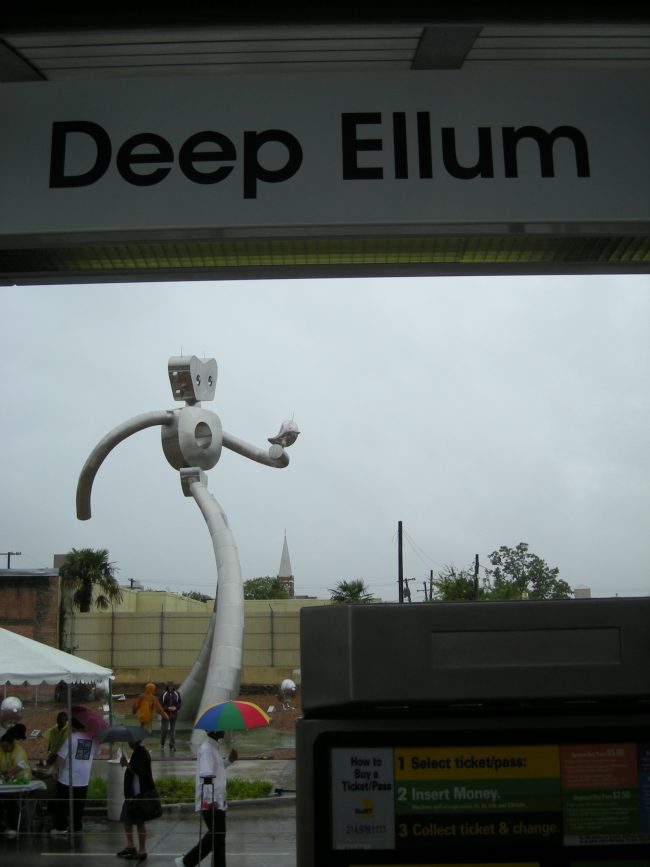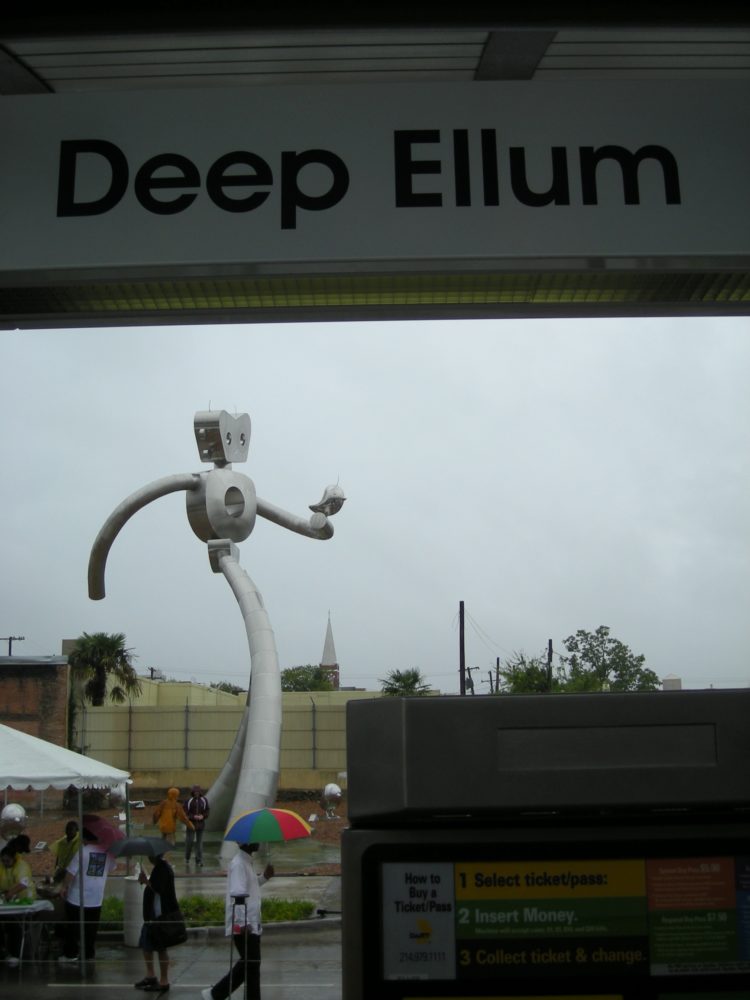
One of three parts in The Traveling Man sculpture series along Good Latimer Street. JOSHUA PARR/The Daily Campus
The rain beats against the windows as the DART train approaches the new Deep Ellum station. The train doors open to a slippery platform and passengers exit to the sound of music playing from across the track. A band plays at the end of a long line of white tents on Good Latimer Street.
Visitors, with umbrellas in hand, make their way from tent to tent, chatting with representatives from local restaurants like Deep Sushi. People with organizations like the Deep Ellum Community Association hand out pamphlets and fliers to upcoming events in the area.
A local artist draws on a large canvas as onlookers watch. “Even the rain couldn’t stop the train,” he writes.
This was Super Saturday, an event designed to bring people back to Deep Ellum. The new DART Green Line opened on Sept. 14, marking the beginning of a revival to the area. The neighborhood is flourishing, galleries are popping up, clubs are returning and restaurants and retail shops are making a comeback.
Merchants, residents and city leaders said it may be a rainy day in Deep Ellum, but the future has never been clearer.
“We are all working together for once to improve the area,” said Randee Smith Prez, the DECA event coordinator.
Deep Ellum has seen its share of hard times. It started out in the early 20th century as a region where many different ethnic groups settled. It was an area known for its jazz and blues music, but through the 1950s it became an area of crime and bankruptcy. Deep Ellum saw resurgence in the 1990s when the rock ‘n’ roll scene took hold. However, in recent years, the area has been down on its luck.
Some people believe Deep Ellum will never return to its former glory.
In his 1998 book, “Deep Ellum and Central Track: Where the Black and White Worlds of Dallas Converged,” author Alan B. Govenar wrote, “Nothing is going to revive Deep Ellum because it was a different world, one that existed because of an odd confluence of racism and tolerance, hard luck and opportunity, sadness and hope, desperate poverty and good-time Saturday night.”
However, community leaders still have hope for a bright future for the neighborhood and are making strides to bring people back to the area.
It starts with the new DART Deep Ellum station. This station is one of the most important aspects of the effort because it will provide easy access to Deep Ellum. When the entire Green Line is completed in 2010, it will bring visitors from all over the Dallas area. This will allow for greater economic development, said Dallas City Council member Pauline Medrano.
The Good Latimer Street tunnel was destroyed to make way for the DART station. The underpass had acted as a “gateway” to the area and became a canvas for local muralists.
“It was heart-breaking when the tunnel went away and construction really hurt business,” said Tiffany Kieran, a member of DECA. “But now there is a rejuvenation of optimism. It’s going to get better.”
Now, DART has set out to provide the area with another “gateway” for Deep Ellum, with the Traveling Man. The community hopes this three-part, stainless steel sculpture series, designed by artists Brandon Oldenburg and Brad Oldham, will be the icon of the area and will welcome neighborhood visitors and residents.
Along with the Traveling Man sculptures, the community is adding more murals around the area to restore the artistic signature of Deep Ellum. DECA kicked off the Deep Ellum Mural Project, calling local artists to restore the murals lost when the Good Latimer Street tunnel was demolished.
Also, the Art Park under the I-45 bridge has recently reopened after years of decline. The Deep Ellum Foundation received a grant to get the park’s lights fixed and local artists were asked to submit designs for the blank canvases. The 20 artists whose works were chosen had 30 days to paint. Artists were paid $120 along with the reward of their artwork being on public display for two years.
In some cases, artists were working up to the night before the ribbon cutting ceremony. One artist, Isaac Davies, was called in at the last minute because another artist became ill. Davies started painting the day before without any ideas prepared. Luckily, he was able to finish in five hours.
“I think it’s good for the community, I mean, art never hurts,” Davies said.
Sean Fitzgerald, DECA president, said while in the process of restoration, the community is stressing three touchstones for Deep Ellum: diversity, creativity and organicity. That means, Fitzgerald said, the community promotes Deep Ellum to be a welcoming place, a place to chase your dreams and a place that was never planned. That is, Deep Ellum is a place that just happened.
The area originated as “Freedman’s Town,” where Elm Street and the Houston and Texas Central Track ran through Dallas. The area was unique in that it had a mix of different ethnicities. Blacks and Jews, who were subjected to social discrimination and racism, settled in this area and coexisted peacefully. Through the 1920s and ’30s, Deep Ellum functioned as a hot spot for jazz and blues music and was home to many pawnshops, bars and clubs. The demise of Deep Ellum started in the 1940s when the Central track was pulled up to make way for Central Expressway. In the 1950s, businesses started to move to suburban areas, and local shops couldn’t compete with larger supermarkets. The crime rate started to rise in the 1960s with frequent violent attacks at bars and clubs. The area finally showed some signs of life in the late 1980s when clubs began to reopen for the rock ‘n’ roll scene. Through the 1990s, Deep Ellum was a hot spot for music that featured bands like Nirvana and Radiohead.
During this time, the area became a home for many art galleries, restaurants and boutiques. In the late 1990s, the city created new zoning laws that required bars and clubs to be 18 and over. This caused bars to lose money and eventually move out of the area, according to Deep Sushi manager, Blake Newsom.
Now, Deep Ellum is coming back to life. According to Medrano, popular clubs like Trees are reopening. The city is leasing to new and responsible businesses, and art galleries are popping up everywhere.
The housing market for Deep Ellum has been steady throughout the years. There are 30 vacancies out of 350 properties in the area, said Bridgette Rogers, Deep Ellum property manager.
One of Deep Ellum’s major issues is the many misconceptions of crime in the area.
Govenar wrote, “Some Dallasites are afraid to go to the area because of occasional incidents of violence, though it is probably safer than many other areas of Dallas.”
In recent years, the area has been notorious for violent attacks; however, the crime rate in Deep Ellum has decreased 17 percent in 2009, according to a report released by the Dallas Police Department.
“There is a distinct difference from six years ago,” Medrano said.
Years ago Deep Ellum made its mark on Dallas as the center for music, art and entertainment. Though it has been through some rough patches, the area is back on the map and on its way to major economic development. All the pieces are there, a new DART station, a lower crime rate and a dedicated community; it’s only a matter of time before Deep Ellum is back on top.
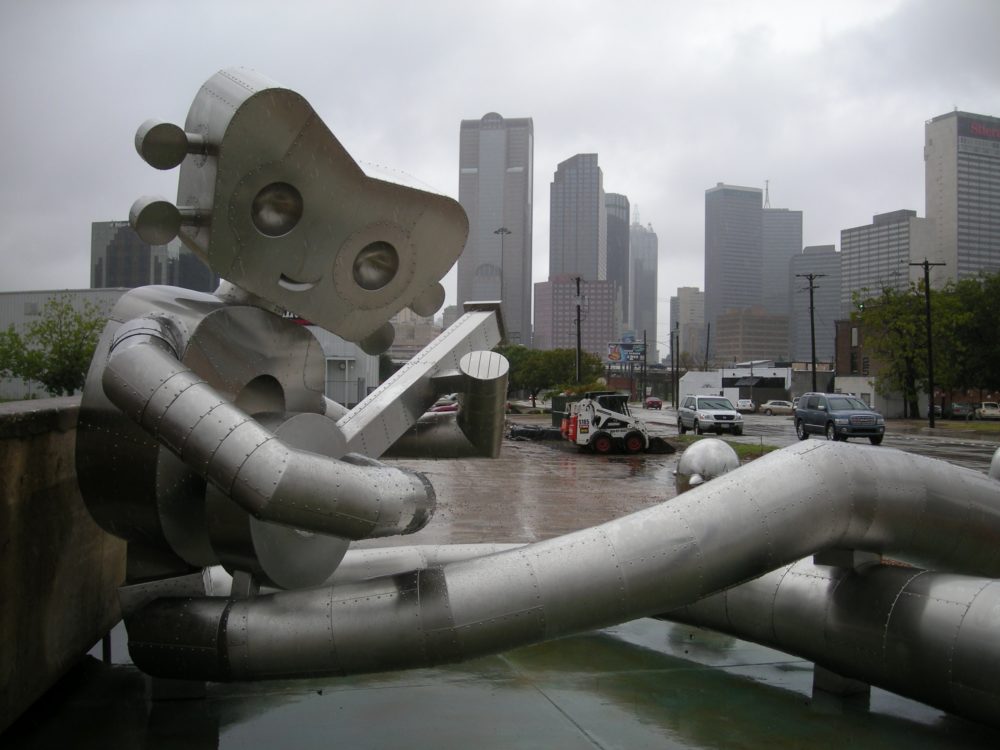
“Waiting on a Train” is one of three parts in The Traveling Man sculpture series along Good Latimer Street. JOSUA PARR/The Daily Campus
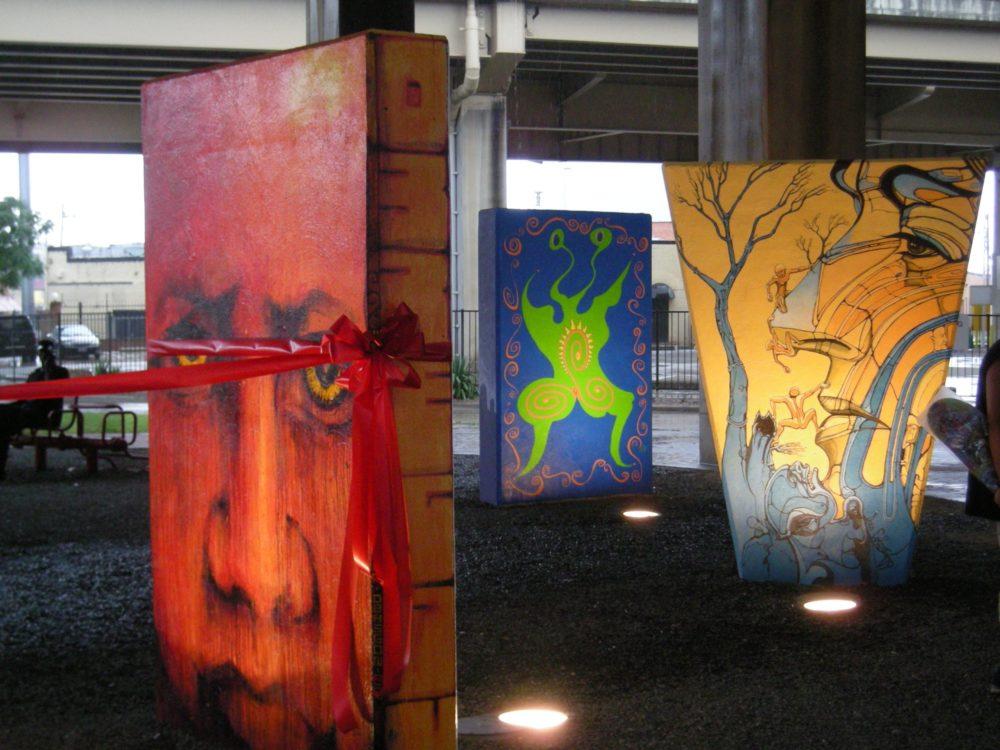
The Deep Ellum Art Park under the I-
45 bridge was reopened Sept. 12. JOSHUA PARR/The Daily Campus
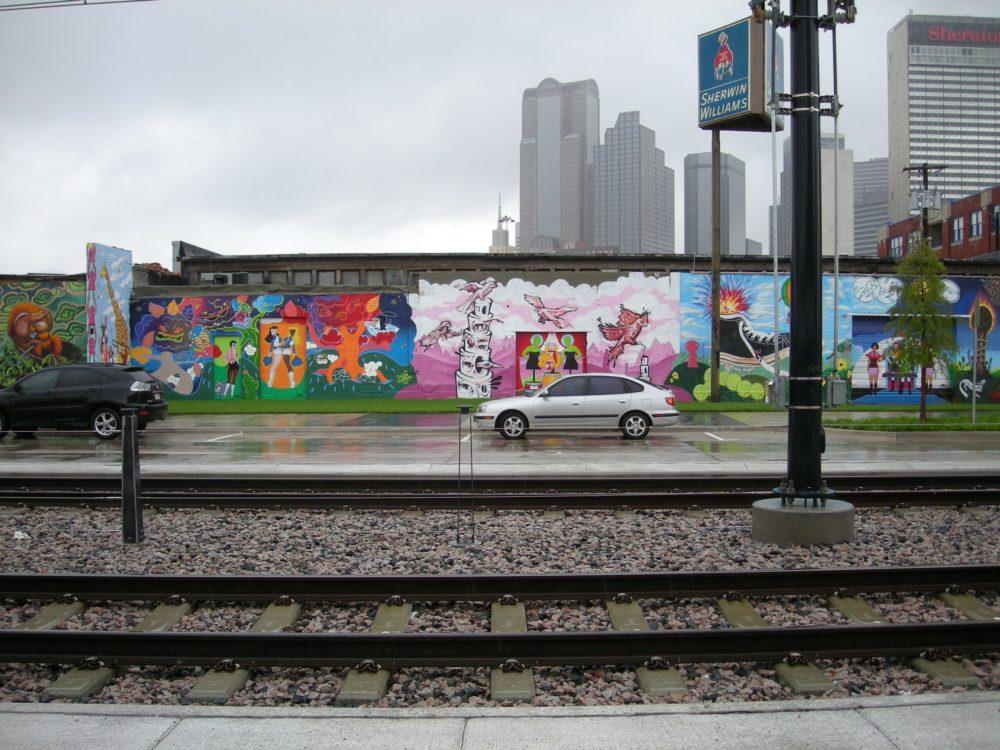
Local artists painted murals along Good Latimer Street to replace artwork lost when the Deep Ellum tunnel was demolished. JOSHUA PARR/The Daily Campus



